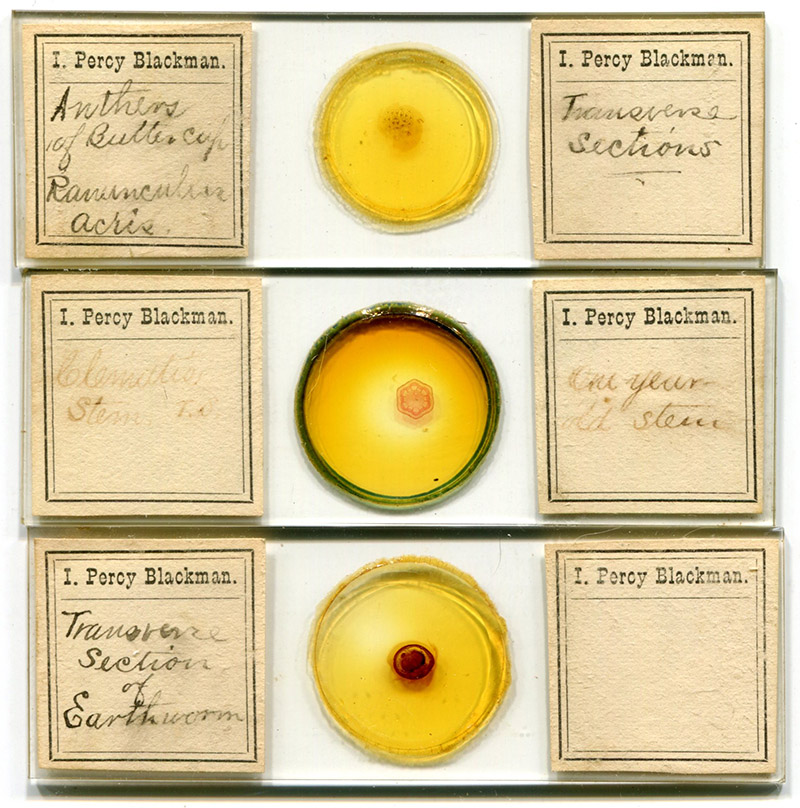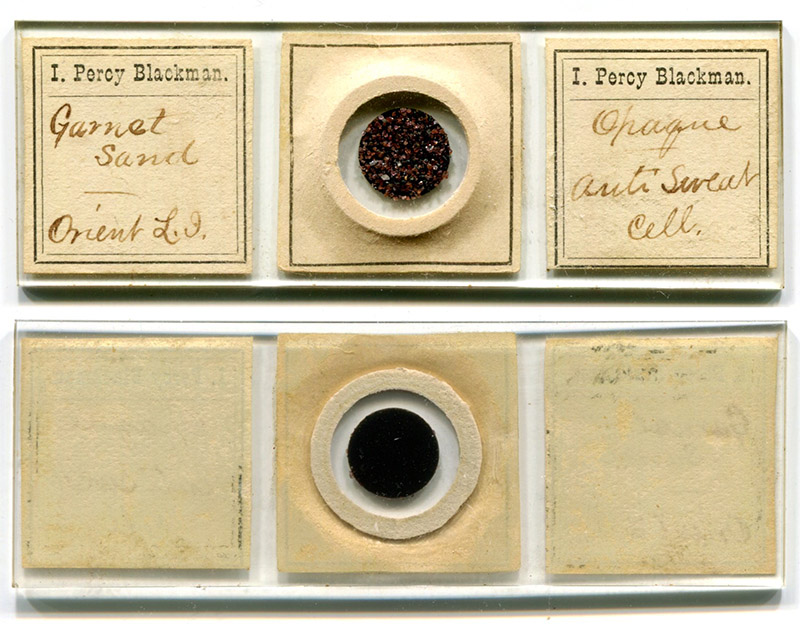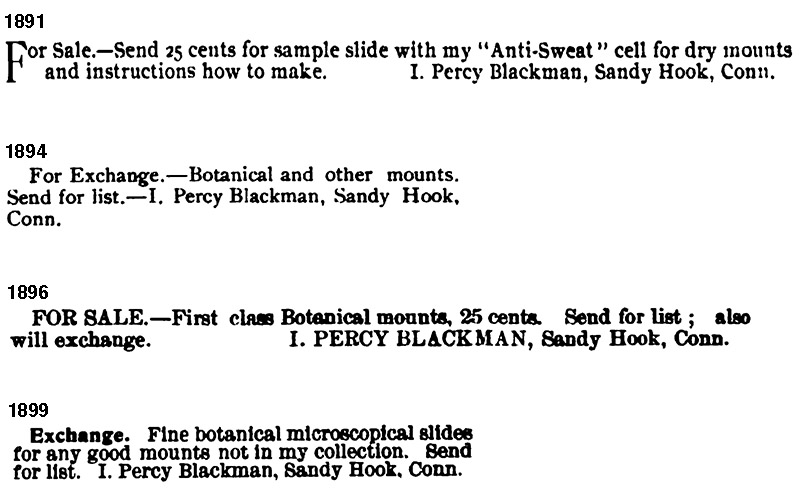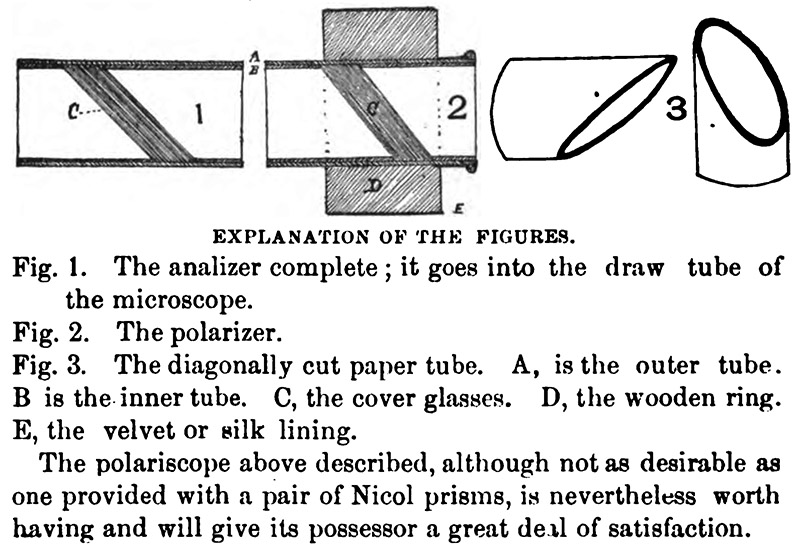
Figure 1. Microscope slides by I. Percy Blackman, circa 1890s.
Isaac Percy Blackman, 1853 - 1925
by Brian Stevenson
last updated November, 2020
I. Percy Blackman was an amateur / semi-professional slide-maker who was active during the 1890s. He was the superintendent of a rubber manufacturing business in Newtown, Connecticut, USA, and lived nearby in Sandy Hook. His exchange offers, and his entries in scientific directories, indicate deep interests in botanical subjects. Blackman mounted other types of specimens, though, including animal and mineralogical items.

Figure 1.
Microscope slides by I. Percy Blackman, circa 1890s.

Figure 2.
Front and rear views of an example of Blackman’s “Anti-Sweat Cell” for dry-mounting - in 1891, he advertised to sell an example and instructions for 25 cents (see Figure 3). The cell appears to be made of paper or another fibrous material, presumably of a composition that draws moisture away from the specimens.

Figure 3.
Exchange and sales offers from I. Percy Blackman, spanning the 1890s. He moved from Sandy Hook, Connecticut to Passaic, New Jersey in 1900 - I have not located evidence of Blackman continuing with microscopy after that move.
Isaac Percy Blackman was born on April 13, 1853, in Newtown, Connecticut. He was a younger son of Ebenezer and Sally Blackman, and grew up on their farm.
In 1876, Percy began working at the New York Belting and Packing Company in Newtown, a manufacturer of rubber products. His elder brother, James, was bookkeeper for the firm, and the 1880 census recorded that Percy was “assistant bookkeeper”. At the time of the 1880 census, Percy lived with James and his family. In time, I. Percy Blackman rose to be superintendent of the company.
On December 23, 1884, Percy Blackman married Jessie Pauline Mitchell. They had two surviving children, Pauline (born in 1891) and Olive (born in 1897).
Percy Blackman is first noted as having microscopical interests in 1891, with his publication of a paper on “Vegetable histology”.
Later that year, he offered to sell microscope slides with his "Anti-Sweat" cells for preparing dry mounts, along with instructions on how to make the cells (Figures 2 and 3). The nature of those cells is not known to me, although they appear to be a form of paper.
In 1893, Blackman published a method for producing an inexpensive polarizing apparatus for the microscope (Figure 4). His instructions were reprinted in several additional popular magazines.
A common way for an amateur microscopist to generate interest in exchanging material, or for a professional to build business, was to send free samples to editors of microscope-oriented magazines. In 1894, The Observer wrote, “From Mr. I.P. Blackman we have received an excellent section of tongue of rat, hardened in alcohol, embedded in celloidin and stained with eosin”. The following year, “We have received from I.P. Blackman a slip containing cabbage worm silk, spun as described in his article which we shall soon publish”.
Calling the attention of magazine editors could also generate direct referrals. For example, an amateur microscopist wrote to The Microscope during 1892 in quest of slides of Volvox globator, to which the editor responded, “Various dealers report themselves out of volvox at present. I. Percy Blackman, of Sandy Hook, Conn., used to have slides and promises some more the coming July or August. Write to him”.
Blackman often published tips and insights for his fellow microscopists. Publications included “Vegetable histology” (1891), “Something more about Volvox” (1895), “Animal tree” (1895), “Brake fern (Pteris aquilina)” (1896), and “Metol developer for photo-micrography” (1896).
Blackman occasionally published requests for help from colleagues. In 1895, he asked for “A medium for animalculae”: “Can any of the readers of Practical Microscopy tell me through its columns of any medium in which the fresh water animalculae, such as Cyclops, Hydras, Daphnia, Chydorus, Water Bears, etc., etc., can be successfully mounted. I have tried one or two media which gave unsatisfactory results. The season has arrived when our ponds and ditches are teaming with animal life, and it would be a ‘joy forever’ to be able to mounts some of these queer creatures satisfactorily if only for the purpose of photographing them”. In 1897, he requested help in “Staining vegetable cells”: “I am working now on the resting nucleus, and kanyokinetic figures, in vegetable cells of the onion, but am sort of groping in the dark, not knowing the length of time for fixing, staining, etc. I am using Fleming's chrom-osmic-acetic acid solution for fixing, imbedding in paraffine, haematoxlin stain, but do not meet with first class results. Would like suggestions”.
In 1900, the New York Belting and Packing Company moved to Passaic, New Jersey, and superintendent Blackman moved with the business. I have not found any records of Blackman being involved with microscopy after that move. It is likely that he had colleagues in Sandy Hook with whom he shared his interest in microscopes, and the absence of that camaraderie dampened Blackman’s enthusiasm. The Botanists’ Directory and Naturalists’ Directory continued to list Blackman through the early 1900s, but provided his Sandy Hook address, while also noting that they had not recently received word from him.
I. Percy Blackman died in early February, 1925, in Passaic. His body was buried in Sandy Hook.

Figure 4.
Blackman’s illustration of his “Simple Home-Made Polariscope”, 1893. Transmitted light is polarized by stacks of thin glass cover slips, placed at an angle to the light path. His description for production and use: “Make a paper tube to fit the draw tube of your microscope. This can be done by gumming writing paper and winding it around a cylindrical stick of the proper size. To this paper tube is to be fitted a second tube that will slip inside of the tube. The outside tube should be about 14 inches long and the internal tube about 5 inch shorter. Cut this internal tube diagonally through the centre at an angle of about 35 degrees, as shown in Figure 3. Procure from a dealer in supplies for microscopists, about three dozen elliptical cover glasses. Insert one piece of the inner tube, and sixteen of these cover glasses, and then put in the other half of the tube, will hold the glasses in place between the ends of the diagonally cut tube. This forms the analizer, and is now ready for use. The cover glasses should be thoroughly cleaned before using, and the paper tubes should be made dead black, inside and outside. The part that goes below the stage is the polarizer, and is made in precisely the same way except the attachment to support it in position for use under the stage. This, each one can devise to suit his instrument. If you have a "stage ring” to your microscope, an attachment can easily be made, by having a wooden spool or ring turned to slip into the stage ring easily, with a hole in the centre of the wooden ring large enough to hold the polarizer. Around the outside of this wooden ring, glue a piece of silk to prevent it from falling out of the stage ring, but it must be capable of being turned. The illustrations represent one that I have made, which works nicely and it cost me only about 75 cents. For the outside tube of my polarizer, I utilized a No. 12 gauge paper shot shell, using the bottom part by cutting a hole through the brass end. This leaves a rim on the end to take hold of to turn the polarizer.”
Resources
The American Monthly Microscopical Journal 1896) Advertisement for sale of slides by I.P. Blackman, Vol. 17, multiple editions
Blackman, I. Percy (1891) Vegetable histology, The Observer
Blackman, I. Percy (1893) A simple home-made polariscope, The American Monthly Microscopical Journal, Vol. 14, pages 257-258
Blackman, I. Percy (1895) Something more about Volvox, The Observer, Vol. 6, page 9
Blackman, I. Percy (1895) A medium for animalculae, The Observer, Vol. 6, page 112
Blackman, I. Percy (1895) Animal tree, The Observer, Vol. 6, pages 133-134
Blackman, I. Percy (1895) Brake fern (Pteris aquilina), The Observer, Vol. 6, pages 417-419
Blackman, I. Percy (1895) Metol developer for photo-micrography, The Observer, Vol. 6, page 547
Blackman, I. Percy (1897) Staining vegetable cells, The Microscope, Vol. 5, page 167
The Botanists' Directory (1902) “Blackman, I. Percy, M.D., - Sandy Hook, Conn. (Botanical preparation for the Microscope. Exchange.” (note that Blackman did not have an M.D. degree, and had moved to New Jersey in 1900), I. Dörfler, Vienna, page 241
The Bridgeport Telegram (1925) Note on the burial of I. Percy Blackman, February 19th edition
Johnson, Ezra Levan (1917) Newtown's History and Historian, Johnson, Newtown, Connecticut, “Universal sorrow was expressed when, in 1900, it was announced that N.Y. Belting and Packing Co. was to move its business to Passaic, N.J. Many families went with them, while some, who had made for themselves pleasant homes, remained, hoping that some other industry would take the plant. Mr. I. Percy Blackman, a Newtown boy who commenced work with them in 1876, went with them and is now their superintendent, with a force of 1200 hands. In 1916, they turned out over 12,000,000 pounds of rubber goods. Thanks are due to Mr. I. Percy Blackman for some of this information, also to Mr. Anthony Patch, oldest resident of Sandy Hook.”
The Microscope (1891) Exchange offers from I. Percy Blackman, Vol. 11, multiple issues
The Microscope (1892) Where can I get a slide of volvox globator?, Vol. 7, page 106
The Naturalists' Directory (1895) “Blackman, I. Percy, Sandy Hook, Ct., Bot: Ferns, Mosses, Algae, Desmids, Diatoms, Mic., Emb., Histol., Protozoa. C. Ex.*” (notes: “C.” and “Ex.” indicated that Blackman collected and exchanged specimens, respectively. The asterisk indicated that the publisher had recently heard from Blackman about his interests), S.E. Cassino, Boston, page 19
The Naturalists' Directory (1905) “Blackman, I. Percy, Sandy Hook, Ct., Bot: Ferns, Mosses, etc. C. Ex.” (note the absence of an asterisk, indicating that the publisher had not heard from Blackman, and that Blackman had moved to New Jersey in 1900), S.E. Cassino, Boston, page 19
The Observer (1894) Editor’s note on a slide by I.P. Blackman, Vol. 5, page 158
The Observer (1894) Exchange offers from I. Percy Blackman, Vol. 5, multiple issues
The Observer (1895) Editor’s note on a slide by I.P. Blackman, Vol. 6, page 13
Popular Science News (1899) Exchange offer from I.P. Blackman, Vol. 33, page iv
U.S. census and other records, accessed through ancestry.com